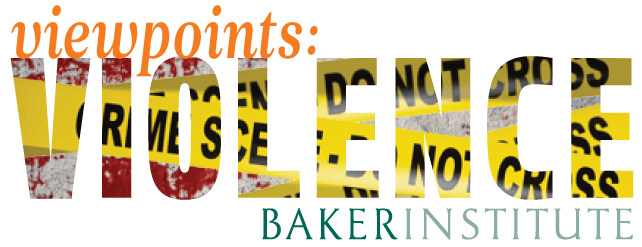
Despite taboos and lost legitimacy, armed groups around the world engage in extreme acts of violence, symbolic and otherwise. In order for decision-makers to understand what can be done about the increasing brutality, they must understand what’s behind it. In the fourth installment of Baker Institute Viewpoints, an institute postdoctoral fellow in drug policy and two outside scholars conducting doctoral research on these issues explain why some armed groups utilize extreme symbolic forms of violence, and how they justify their actions. In the final post of the three-day series, Nathan Jones, the institute’s Alfred C. Glassell III Postdoctoral Fellow in Drug Policy, explores the underpinnings of drug-related violence in Mexico.
Extreme and symbolic violence has become a form communication in the context of weak Mexican state capacity and the presence of powerful organized crime groups. It is important not to exaggerate the use of symbolic violence in the Mexican “drug war,” as it can lead to false understandings. Before explaining how extreme violence is used in the context of Mexico, we must first understand Mexican drug violence in comparative and historical context.
Homicide rates in comparative perspective
Based upon media accounts in the United States, many believe that Mexico is extremely violent. Indeed in comparison to United States’ homicide rates of less than 5 per 100,000, Mexico does appear high. It should noted that these homicides are often highly localized and vary by region. Violence must be kept in perspective. Mexican homicide rates of about 24 per 100,000 (preliminary data 2011) are a fraction of other Latin American countries such as Venezuela (49 per 100,000 in 2009), Honduras (82.1 per 100,000 in 2010) and El Salvador (66 per 100,000 in 2010). As Harvard doctoral candidate Viridiana Rios has argued, Mexico suffers from “mediatic violence” that is more likely to grab headlines and capture public attention.
Why do once relatively peaceful Mexican cartels now use extreme and symbolic forms of violence?
Let me begin by ruling out common causal explanations. I am extremely skeptical of cultural explanations of violence in Mexico. Mexico’s homicide rates were on a downward trend for decades — until the end of the administration of President Vicente Fox (2000-2006), according to Rios’ dissertation. Nor do I believe that the drug war has tapped into some mythical violent pre-Hispanic past, given those previously descending rates of violence and other stronger structural explanations.
Structural explanations of violence
Structural explanations about the changes in the government and society better align with the timing of increased violence. Many blame President Felipe Calderon’s crackdown on drug trafficking organizations for the violence. As Rios has shown, the problem was simmering before he took office. He simply pulled the lid off an already boiling-over pot and through kingpin strategies exacerbated inter- and intra-cartel conflicts.
Mexico’s higher levels of violence stem from a change in the macro state-cartel relationship and took decades to become apparent. In the 1980s the relationship could be characterized as “collusive,” as Shirk and Astorga argue. But following the death of American DEA agent Enrique Camarena, the U.S. government put incredible pressure on its Mexican counterpart to capture those responsible and disband the corrupt Direccion Federal de Seguridad, which had hitherto managed drug traffickers. This led to what Duran Martinez and Snyder argue is a more violent equilibrium caused by the presence of many trafficking groups and many law enforcement agencies that could no longer easily negotiate with each other.
However, in the United States we also possess many law enforcement agencies and many street and prison gangs — yet have low levels of violence. The primary difference is the strength of state institutions. Those committing crimes in the United States can be relatively certain that they will be prosecuted and spend time in prison at some point. This is why Skarbek argues prison gangs can dominate and demand a “tax” from street gangs as he illustrates with La Eme in Southern California. On the other hand, a study from Mexico’s prestigious Instituto Tecnologico de Monterrey estimates the Mexican legal system resolves less than 2% of all crimes, leading to widespread impunity.
The Calderon administration has already begun instituting important judicial reforms, though these will take decades to be fully implemented. Americans should remember our own history of addressing organized crime. The end of Prohibition did not witness the end organized crime power in America. It did, however, deny organized crime significant profits, which weakened it and allowed the U.S. government to strengthen its own law enforcement apparatus, turning organized crime into a manageable problem. This process took decades.
Challenging the drug prohibition regime
An understanding of this history makes it all the more understandable that Latin American leaders such as Guatemalan President Perez Molina are calling for a fundamental reevaluation of the global drug prohibition regime. Faced with weak state capacity and powerful organized crime actors, they believe they must both change the global prohibition regime and strengthen state capacity to hasten the moment when their nations can enjoy low violence equilibriums.
In the context of weak state institutions and a confrontational relationship with the state, Mexican traffickers fight among each other for control of territory to traffic drugs and extort local populations. These organized crime groups have entered an equilibrium, in which, as Michael Hampson argues, symbolic violence has become a cost-effective mechanism of control of local populations and a language to signal dominance in territories where other drug trafficking organizations are present or considering encroachment.
The role of technology
Technology has magnified the effect and reach of symbolic violence. Traffickers have utilized youtube and social media to spread their acts and notoriety. Traffickers time their killings to maximize media coverage and leave narco-mantas or notes for local populations and/or rival traffickers. Social media has proven of limited utility in reporting on criminal actions where traffickers enforce media blackouts. Traffickers have targeted social media users who denounce drug violence with symbolic assassinations.
Whereas established organized crime groups can enjoy the reputation for violence established by previous acts or predecessors, newly organized crime groups must establish a reputation for violence from scratch. Thus, hyper-violent acts like the five severed heads thrown onto a nightclub dance-floor in 2006 announced the emergence of La Familia Michoacana. One of the unfortunate unintended consequences of Calderon’s kingpin strategies has been the creation of more new and reputation hungry organized crime groups as they splinter-off from decapitated “cartels.”
Stronger state capacity will take decades for full implementation
The Calderon Administration sees 2011 as a turning point in which violence levels appear to have stopped their steep climb and it hopes will begin a steady decrease. Unfortunately this may not lead to a significant improvement in the perception of violence because the use of extreme violence by ever more desperate groups facing stronger state institutions are likely to continue until these institutions are sufficiently effective to deter them — a process that will take decades, just as it did in the United States.
 Nathan Jones is the Alfred C. Glassell III Postdoctoral Fellow in Drug Policy at the Baker Institute. His areas of interest include U.S.-Mexico security issues, illicit networks and cross-border flows.
Nathan Jones is the Alfred C. Glassell III Postdoctoral Fellow in Drug Policy at the Baker Institute. His areas of interest include U.S.-Mexico security issues, illicit networks and cross-border flows.